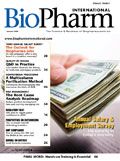Small-Cap Biotech Companies Conserve Cash to Ride Out The Prevailing Economic Conditions
Small biotechs were forced to restructure and downsize.
A rally in the capital markets in the two days either side of the Thanksgiving holiday helped improve the fortunes of a number of industrial sectors, including biotech. The upswing came as welcome news for investors, because at one point late in November the Dow had slipped to 7550, dragging all sectors down with it. By month's end, the Burrill Biotech Select Index, a price-weighted index tracking 20 of biotech's blue-chip companies, closed down almost 7% with the Dow down 5% and the NASDAQ 11% for the month of November.

G. Steven Burrill
Although the past two months have been ugly, with biotech's blue-chip companies shedding 17% of their value, their fundamentals of strong sales and robust pipelines will see them recover, but it will take some time. It is the small-cap biotech companies that will face the greatest challenges. The Burrill Small-Cap Biotech Index dropped 13% in November and 34% since the end of September. Among the 370 publicly listed biotechnology companies tracked by the monthly Burrill Report, 54% of them now have a market cap well below $100 million. We are starting to see a clear pattern evolving for these companies. They are rapidly restructuring as a result of the negative capital markets. Staff is being reduced and many R&D programs have been put "in the refrigerator" until better times prevail.
The Burrill Report identified 15 North American biotech companies that announced restructuring in November. This list will certainly grow in the months ahead as biotech companies look to ride out the prevailing economic conditions. Many may be forced to combine for survival and focus on the one key program between them that has the greatest opportunity for value creation and funding.
A TIME FOR REVERSE MERGERS
There will also be reverse mergers. Many of these will be into public shells or "burnout" companies that have seen their product fail, but still with cash. In such cases, the merger will increase their funding options and provide a pathway to liquidity for their venture capital and private equity investors.
Reverse mergers were once considered by the investment community to be tertiary financing vehicles. They are becoming more widely accepted by venture capitalists as a potential financial event, taking the place of the more traditional biotechnology initial public offering—the IPO window being firmly closed.
Recently, Novacea, Inc. of South San Francisco, which abandoned work on its prostate cancer drug after unfavorable clinical trial results, merged with privately held Transcept Pharmaceuticals. Inc. Under the reverse merger, Transcept will acquire a NASDAQ listing and about $90 million to develop its insomnia drug Intermezzo and other products.
BIG PHARMA AT AN ADVANTAGE
If not restructuring, biotech companies will be acquired at bargain basement prices. For example, Roche snapped up its partner Memory Pharmaceuticals for $50 million. The whopping 319% premium that Roche paid has to be put in perspective since Memory was trading at $0.15 and a market cap of $12 million the day before the announcement. The acquisition means that Roche gains full access to the partnered drug candidates in Alzheimer's disease and schizophrenia it had with Memory as well as its R&D that will augment Roche's own research and development portfolio.
Big Pharma can certainly continue to take full advantage of the fragile global economy to buy assets at a discount. They have the luxury of sitting back and waiting for the right opportunity and then acquiring biotech companies at what represent 1990 prices.
BY THE NUMBERS
The collective market cap of the industry closed November at $375 billion, down 10% for the month (20% since the end of September and 16% year-to-date). Genentech's market cap closed the month at $79 billion; Amgen was at $59 billion and Gilead Sciences at $41 billion.
As tough as these data reveal, three years from now, we will look back at this moment as one of the greatest buying opportunities ever. Some of these small biotechs are great companies with great products and pipelines with superb management that are trading at prices unheard of in their recent past.
G. Steven Burrill is chief executive officer at Burrill & Company, San Francisco, CA, 415.591.5400, publications@b-c.com

Tokyo University of Science Research Team Explores Improved Delivery of Antisense Oligonucleotides
April 18th 2025Using cholesterol-modified oligonucleotides, the research team aims to improve the delivery of antisense nucleotide-based therapies for treating neurodegenerative diseases and brain cancers.